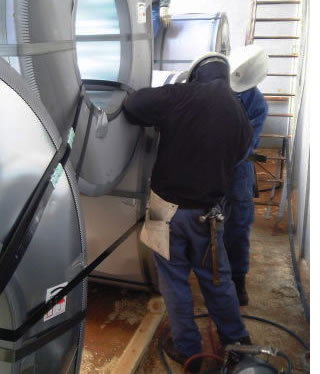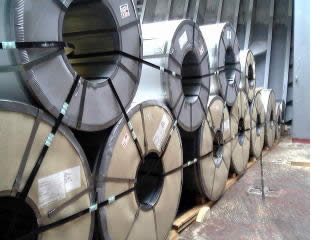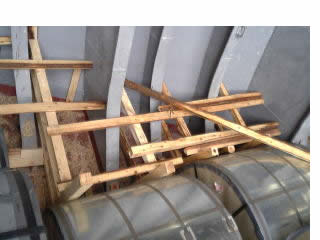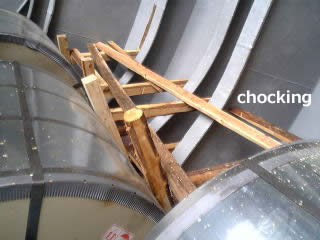
Basically, they are working on the conventional vessels.
The basic materials they use are,
'steel wire rope', 'wire clip', 'turnbuckle', 'shackle', 'nail', 'square lumber', 'half cut square lumber'.
Because of the environmental and financial reason, some of the materials are being replaced. The polyester lashing belts and Eco-Lash* are one of the new materials.
The basic tools they use are,
'hammer', '19mm & 21mm ratchet wrench'.
*Eco-Lash is TOYOTA TSUSHO CORPORATION's products.
 This photo is the inside of the cargo ship.
This photo is the inside of the cargo ship.
Today, we will load and fasten the "steel coils".Now, they just finished the preparation and the first steel coil is just placed by the forklift.
 Although, this is the different HOLD*. The steel coils are placed one by one. The coil's maximum weight is just over 14,000kgs.
Although, this is the different HOLD*. The steel coils are placed one by one. The coil's maximum weight is just over 14,000kgs.
The carpenters are using the steel belt for the lashing today. Basically, they put the belts on the coils placed in a line.
*HOLD is the cargo room's name. We call lower room "HOLD" and upper room "UPPER DECK". Sometimes, some cargos are put on the deck covers.
 The coils are located on the 2nd tier.
The coils are located on the 2nd tier.
The carpenters are working on the coils. They are putting the belts on the coils. Side by side and upper one to lower one.
 This is the picture of the cargo completely fastened.
This is the picture of the cargo completely fastened.
Would you like to have a look around the side wall of the vessel? The next picture is one of that.
Also, you can find what is happening between the coils.

These are the chocking by using square lumber.
Does it look like the framework of a house? This is the reason that we are called the "CARPENTER".
These places are very difficult to put the chocking on. Because, the vessels wall is slanting and the cargos are round shape.
But, Kinoshita Carpenter's chockings are NOT even wobbled.
